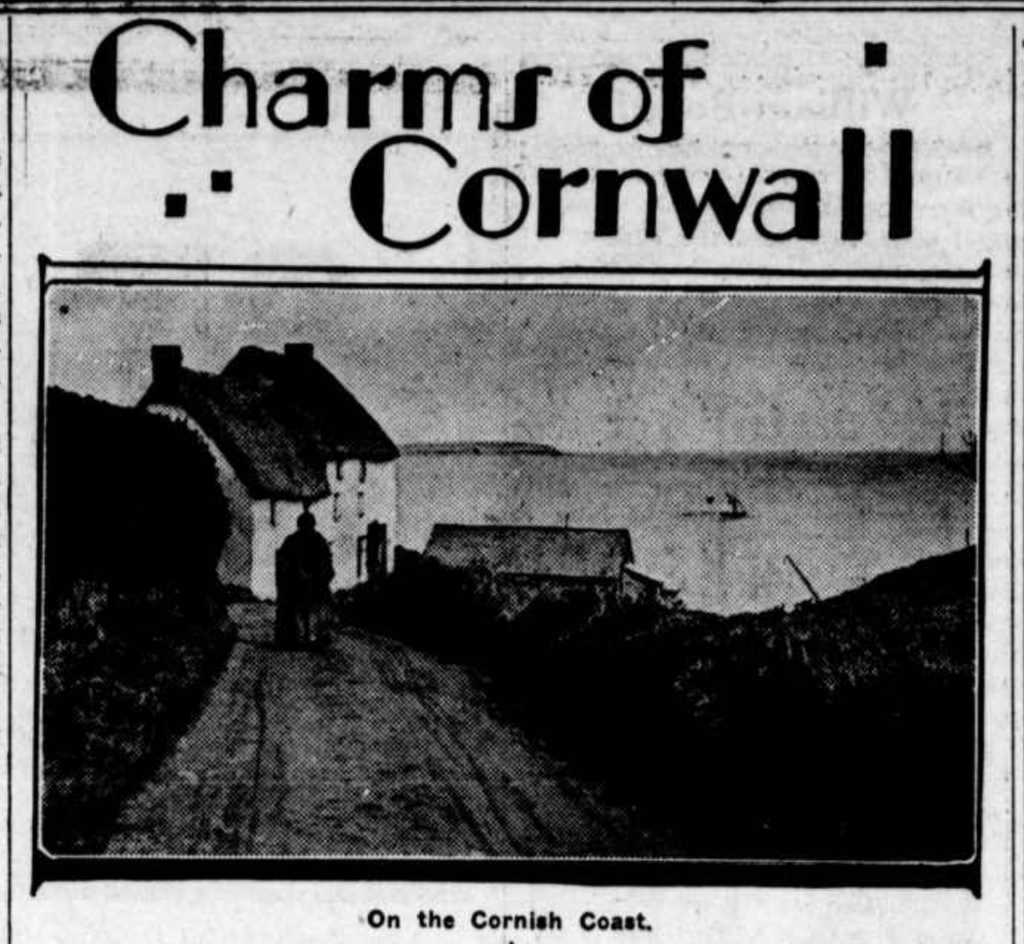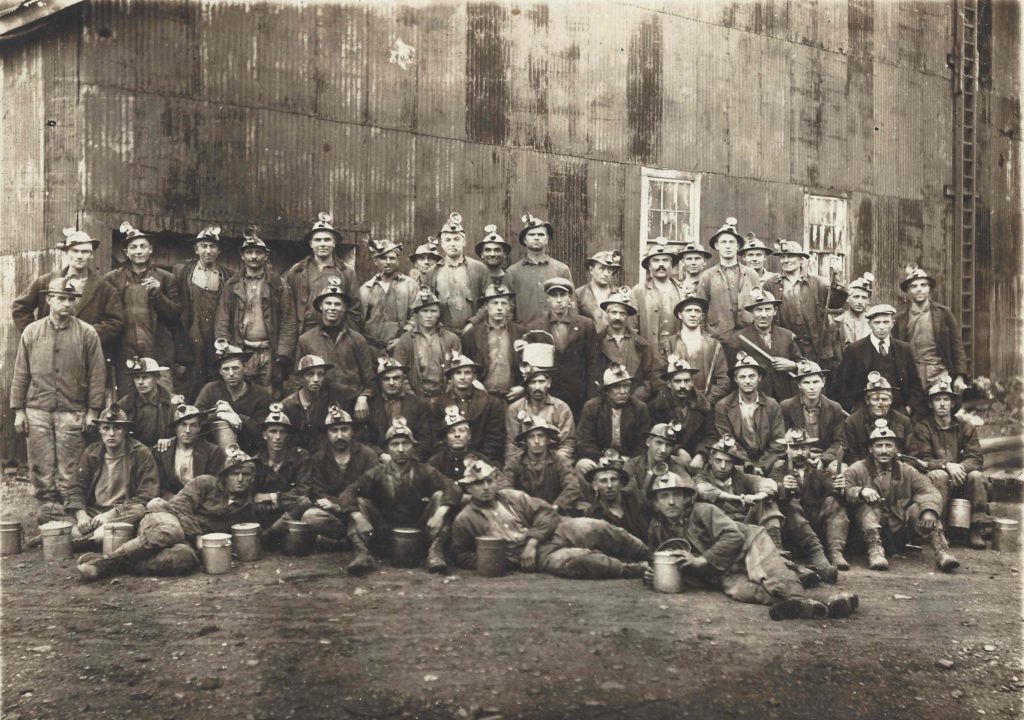COMING SOON!
As the old saying goes, “Wherever there is a hole in the earth, you will find a Cornishman at the bottom.” People of Cornish heritage can be found all over the world, although many of them, being so far-removed from their immigrant ancestors, may not even know it. This site is dedicated to celebrating Cornish ancestry, and providing information relating to “Cousin Jacks” and “Cousin Jennys” from Cornwall to Australia, South Africa, Mexico, Canada, or the United States.

(Prepared by the National Geographic Society, Washington. D. C.)
HE WHO has traveled the roads through Cornwall, England’s southernmost county, recalls the vast moors, dull, dun, and bare, on which the only interruption to the eye’s range is an occasional ruined pithouse, through the gaps in which one glimpses the blue sky; or a tumbled heap of earth where once Phoenician tin miners, perhaps, sought the metal which a Cornish historian once declared “near as fyn as sylver.”
At long intervals a cottage is encountered of dour gray granite, roofed with granite, breastplated against the driving rains with slate, in a granite-walled inclosure, with never a shrub or tree to vary the cold monotony with a touch of green.
But Cornwall has charm and It is a charm of enchantment. Its moors are broken by hidden valleys, the existence of which one does not suspect until their lips are reached, filled with the greenest grass, from which great trees tower. The hedges that rim in the roads, worn down by centuries of traffic, glow with the purple of foxglove and the yellow of the furze. In an hour’s drive one passes from cliffs of a savage, sheer hostility, at whose feet break the most dangerous seas in England, to smiling estuaries amid rolling hills on which the green of English oak alternate with glowing fields.
History and tradition play their parts in creating Cornwall’s charm. It was on Cornish shores that galleys landed in search of tin long before the Roman rule in England. Local tradition holds that Jewish traders gave its name to the little village of Marazion—Bitter Zion—which is at least as often called Market Jew by the country people as by its own name. It is a pity that archeologists laugh at this fanciful etymology. Offshore the Land of Lyonesse lies sunken with its 140 parish churches, whose bells, the fishermen say, may still be heard on days of onshore storms.
Wreckers and Smugglers.
It is not many years since wrecking was an established industry there, and the parson’s lame mare, with a ship’s lantern tied under her neck, was set to hobble of an evening along the sands, to toll bewildered shipmen on the rocks. Cottagers drop pins in the holy wells and read their fortunes in the bubbling of the disturbed waters.
The county names are an everchanging delight. Can there be a more charming title for a church than St. Just In Roseland? One crosses by Slaughter bridge straight into a remote and furious past.
Almost every little seacoast town has its smugglers’ cave with a well authenticated history. From the Lizard the Spanish Armada was sighted and alarm fires were lighted. During Cornwall’s all too intermittent spells of prosperity, miners emerge from workings beneath the sea and climb ladders pinned to gigantic cliffs, singing as they mount. Oranges and lemons and exotic palms grow in the balmy air.
It was in Cornwall that George Fox, Quaker, was chained in a noisome dungeon for months. Here John Wesley preached to congregations of 50,000, in an amphitheater, built, perhaps, by the heathen.
It was on the border of Cornwall that girt Jan Ridd rode against the Doones, and John Ridd is still a warden in the very church In which Lorna Doone was shot down at the altar. Clovelly is just across the line in Devon, and Clovelly is one of the loveliest villages In England.
Cornwall furnished and still furnishes the best hard-rock miners in the world. They despise coal mining, do these men whose ancestors have for generations searched for tin and copper in mines that are at once among the deepest and the most meagerly equipped in the industry. Where gold or silver or copper is to be burrowed for under mountains, they are to be found as leaders in their craft. However, because of their extraordinary clannishness and their strongly marked racial and individual idiosyncrasies, they often do not impress themselves on the popular affection. One recalls them in our Western states, in an environment at once foreign and hostile, as harsh and silent men, who put a high estimate on themselves and were candid, and perhaps justified, in their doubts of the rest of mankind. Their more sociable moments seemed devoted in almost Masonic secrecy to the discussion of an Iron-bound religion.
But it is difficult for a visitor to Cornwall to understand this Western misconception of the Cornish character. Certainly no more kindly or hospitable man exists than the Cornishman upon his native heath. Yet the Cornish are assuredly a race apart. Just as Cornwall differs in aspect from its neighboring county of Devon.
Cornish People a Race Apart.
Formed of a union of the primitive tribes and the Brythonic race which gave its name to Britain, and only slightly modified, according to students of the race history, by succeeding invasions of Romans, Saxons and Norsemen, they kept their own language until well in the Eighteenth century. They will speak of “going to England,” as if it were a foreign country.
Cornwall is the southwesternmost county of England. It is a great promontory, 75 miles in length, armored against the sea with granite, slate, and serpentine, and 45 miles wide at its greatest, where the River Tamar bars it from Devon. It contains approximately 1,350 square miles and 300,000 people.
Thanks to the Atlantic ocean and the Gulf stream on one flank of its triangle, and to the sheltered waters of the English channel on the other, its climate is in great part so extraordinarily warm and equable that enthusiasts refer to its coast as the Cornish Riviera.
It is true that snow seldom lies, and it is also a fact that in a comparison of average mean temperatures the advantage would be altogether in favor of certain Cornish watering places as against the winter climate of the Mediterranean coast.
Yet one should not take these assurances altogether at their face value. The winds of Cornwall are so rough that in the uplands the few small bushes one sees are dwarfed and twisted, and about Lands End the windowpanes are ground to opacity by the blowing sand.
Cornwall is an unchanging land. No doubt Diodorus, who wrote of his visit to Cornwall in the time of Julius Caesar, found Lands End just as it is today, save for a few excrescences of inns and lighthouses and lifeboat stations. The very name has not been disturbed, for Lands End is the Celtic Pen-von-Las, which literally means ‘‘the end of the earth.” What is the name of the Longships lighthouse, battered by waves on a rock nearby, but a translation of naves longae—“long ships”? And does not the rock on which it stands suggest a Roman galley to one of but a little imagination? He who doubts should not come to Cornwall. Yesterday seems very near at hand.
Mines Mostly Abandoned.
The great central plateau of Cornwall is of chief interest to the business man and to the archeologist. There are found the many small towns which depend on the copper and tin mining industries, on farming, or on the great pits from which clay is taken, some of which is sent to China for the manufacture of porcelain. For the most part, the copper and tin mines have gone too deep to be profitable, until some new invention comes to the rescue or prices rise out of all reason. To this cause is due the poverty and depression which may be seen in so many places on the moors.
The Cornishman is a born gambler in hard rock. When it became difficult to attract outside capital, he organized his own local concerns to work mines. Many companies of adventurous miners, too, were formed to work leases on the share plan, just as Cornish fishermen go share and share alike in their boats.
The failure of the mines not only bankrupted their owners, but drove them into other lands. One now sees a pitiful succession of empty houses on the moors—fine, square, granite-built houses that will endure the weather for centuries—and, come to think of it, almost every Cornishman one meets away from home is a miner by trade.
No part of England is as rich in prehistoric antiquities as Cornwall, and nowhere, one may guess, is the study less satisfying to an archeologist. Of the numerous Cornish crosses, about all that can be said is that they date from somewhere between the Fifth and Twelfth centuries, when Cornwall was Christianized by saints from Ireland, many of whom, according to tradition, floated across the narrow seas in stone coffins. But one Cornish cross is perilously like all other Cornish crosses.
